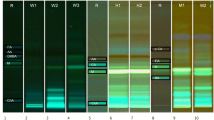Summary
This paper explores the high-performance thin-layer chromatographic (HPTLC) fingerprinting of non-sugar constituents for the authentication of honeys using highly antibacterial Jarrah (Eucalyptus marginata) and Marri (Corymbia calophylla) honeys sourced from Western Australia, different Leptospermum-derived Manuka honeys, and a typical table honey from an undisclosed floral source as test samples. As is demonstrated in this study, using HPTLC fingerprinting, it is possible to define differences in botanical origin as the honey fingerprints exhibit a unique profile of bands (i.e., RF values, color) and peak profiles (i.e., RF and peak intensity values, peak intensity ratios) that differ distinctly from each other. The identification of patterns of common bands among honeys derived from the same floral source as authentication tool is possible. Further, slight differences among honeys from the same botanical origin might be due to age, processing, or regional factors. The HPTLC analysis of two differently aged Jarrah honeys of the same supplier indicates also that future closer investigation of intraspecies differences might assist in develo** HPTLC-supported quality control tools.
Similar content being viewed by others
References
R. D. Forrest, J. R. Soc. Med. 75 (1982) 198–205.
E. Mavric, S. Wittmann, G. Barth, T. Henle, Mol. Nutr. Food Res. 52 (2008) 483–489.
C. Adams, M. Manley-Harris, P.C. Molan, Carbohydr. Res. 344 (2009) 1050–1053.
L.M. Bang, C. Buntting, P. Molan, J. Alternat. Compl. Med. 9 (2003) 267–273.
Ministry for Primary Industries New Zealand (MPINZ), Apiculture Monitoring Programme MPINS, Wellington, 2013.
K.M. Rogers, M. Manley-Harris, NZ Beekeeper J. 23 (2014) 13.
E. Anklam, Food Chem. 63 (1998) 549–562.
K. Beckmann, G. Beckh, C. Lüllmann, K. Speer, Lebensmittelchemie 61 (2007) 132–133.
Z. Jandrić, R.D. Frew, L.N. Fernandez-Cedi, A. Cannavan, Food Control (2015); http://dx.doi.org/10.1016/j.foodcont.2015.10.010.
Y. Kato, R. Fu**aka, A. Ishisaka, Y. Nitta, N. Kitamoto, Y. Takimoto, J. Agric. Food Chem. 62 (2014) 6400–6407.
V. Kaškoniene, P.R. Venskutonis, Compr. Rev. Food Sci. Food Saf. 9 (2010) 620–634.
Z. Jandrić, S.A. Haughey, R.D. Frew, K. McComb, P. Galvin-King, C.T. Elliott, A. Cannavan, Food Chem. (2015); http://dx.doi.org/10.1016/j.foodchem.2014.11.165.
M.N.C. Grainger, M. Manley-Harris, N.A.M. Fauzi, M.M. Farid, Food Chem. 153 (2014) 134–139.
J. Irish, S. Blair, D.A. Carter, PLoS One 6 (2011) e18229.
D. Kasote, A. Ahmad, W. Chen, S. Combrinck, A. Viljoen, Phytochem. Lett. 11 (2015) 326–331.
P. Ristivojević, F.L. Andrić, J.D. Trifković, I. Vovk, L.Z. Stanisavljević, Z.L. Tešić, D.M. Milojković-Opsenica, J. Chemometrics 28 (2013) 301–310.
A. Puscas, A. Hosu, C. Cimpoiu, J. Chromatogr. A 1272 (2013) 132–135.
E.S. Chemetsova, I.A. Revelsky, G.E. Morlock, Anal. Bioanal. Chem. 401 (2011) 325–332.
C. Chen, L.T. Campbell, S.E. Blair, D.E. Carter, Front. Microbiol. 3 (2012) 1–8.
Author information
Authors and Affiliations
Corresponding author
Rights and permissions
About this article
Cite this article
Locher, C., Neumann, J. & Sostaric, T. Authentication of Honeys of Different Floral Origins via High-Performance Thin-Layer Chromatographic Fingerprinting. JPC-J Planar Chromat 30, 57–62 (2017). https://doi.org/10.1556/1006.2017.30.1.8
Received:
Accepted:
Published:
Issue Date:
DOI: https://doi.org/10.1556/1006.2017.30.1.8




